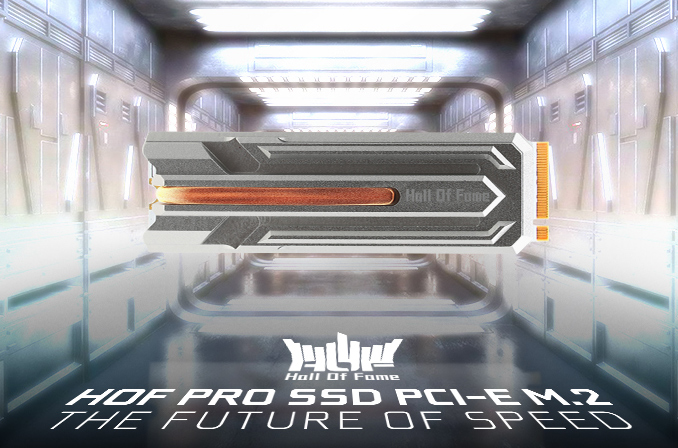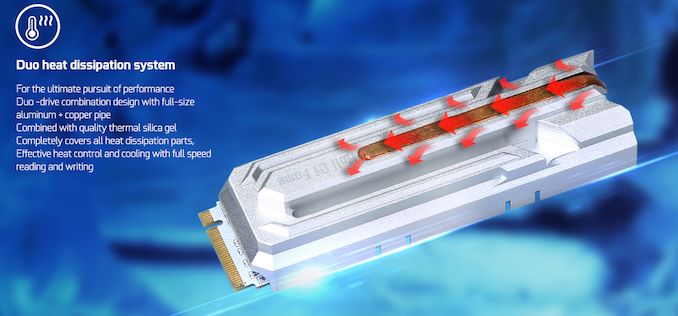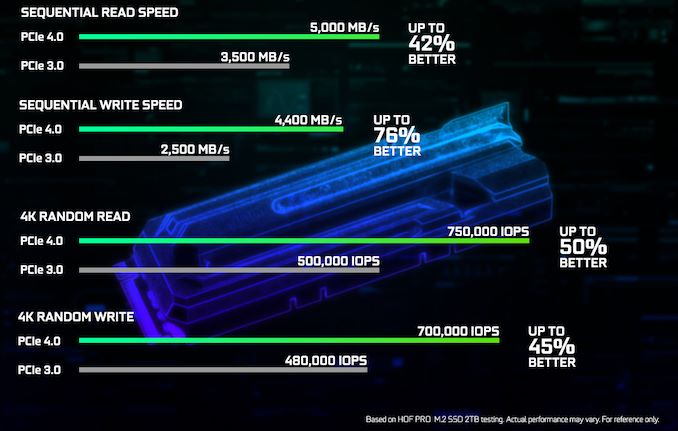GALAX Announces HOF Pro M.2 PCIe 4.0 x4 SSD: Up to 5 GB/s
by Anton Shilov on July 9, 2019 12:00 PM EST
GALAX has introduced its new flagship SSDs featuring a PCIe 4.0 x4 interface and sequential read performance of up to 5 GB/s. The new HOF Pro M.2 drives will demonstrate all of their advantages when installed inside systems based on AMD’s Ryzen 3000-series processors as well as AMD’s X570 based motherboards, as these are currently the only PCIe 4.0 compatible consumer hosts on the market.
Based on Phison’s PS5016-E16 controller (8 NAND channels with 32 CE targets with up to 800 MT/s speeds, 4th Gen LDPC ECC engine, 28nm, etc.) and Toshiba’s 3D TLC NAND memory, the GALAX Hall-of-Fame Pro SSDs are set to be available in 500 GB, 1 TB, and 2 TB capacities.
As far as sequential performance is concerned, the GALAX HOF Pro SSDs offer up to 5 GB/s read speeds as well as up to 4.4 GB/s write speeds, depending on the model and capacity. As for random performance, GALAX opted for firmware enabling up to 750K read IOPS as well as up to 700K write IOPS.
To ensure maximum performance, the GALAX HOF Pro SSDs are equipped with a large aluminum cooling system featuring a copper heat pipe. This cooling system naturally makes the drives incompatible with laptops, but since at present there are no notebooks based on AMD’s X570 platform, this is hardly a substantial drawback. Another important aspect about the new SSD is its white PCB, which will be appreciated by modders with white components.
To make the GALAX HOF Pro drives more appealing to enthusiasts, the manufacturer supplies it with Xtreme Tuner software for SSDs. The application monitors temperature, endurance, and other information about the drives to enable higher performance and reliability.
| Specifications of the GALAX HOF Pro SSDs | |||||
| Model | 500 GB | 1 TB | 2 TB | ||
| Form Factor | M.2 2280 | ||||
| Interface | NVMe, PCIe 4.0 x4 | ||||
| Controller | Phison PS5016-E16 | ||||
| NAND Flash | Toshiba BiCS4 3D TLC | ||||
| Capacities | 500 GB | 1 TB | 2 TB | ||
| Sequential Read (max) | 5000 MB/s | 4900 MB/s | 5000 MB/s | ||
| Sequential Write (max) | 2500 MB/s | 4400 MB/s | |||
| Random Read (max) | up to 750K IOPS | ||||
| Random Write (max) | up to 700K IOPS | ||||
| Warranty | ? years | ||||
| Write Endurance | ? | ? | ? | ||
| TBW | ? | ? | ? | ||
| Release Date | July 2019 | ||||
The GALAX HOF Pro SSDs will be available in the coming weeks. Pricing will depend on the country, yet since we are talking about top-of-the-range drives, the cost will be likely accordingly high.
Related Reading:
- Phison PS5016-E16 PCIe 4.0 SSDs: Random Read/Write Performance Disclosed
- Corsair Announces MP600 NVMe SSD With PCIe 4.0
- More 2TB PCIe 4.0 SSD Options: Patriot with Custom Firmware coming Q4
- TeamGroup Cardea Zero PCIe 4.0 x4 SSD: Up to 1 TB
- Galax Goes White: A PCIe 4.0 2TB SSD with a White PCB
- Essencore 2 TB PCIe 4.0 SSD Enters The Game
Source: GALAX














14 Comments
View All Comments
peevee - Tuesday, July 9, 2019 - link
Any chance the claims will be tested? 750k IOPS sounds nice. At 4k it translates to 3GB/s. Hard to believe. What QD is that, something completely unrealistic (and useless in client systems), like 64? 128?Would be nice to have just 1 but useful metric for the systems, like random 64k reads at QD2.
Because
1) smaller reads don't matter, NTFS runs are 64KiB (16 clusters) each, and with smaller files performance is fast enough as it is.
2) longer sequential reads do not matter much because if 64KiB reads are fast enough, longer sequential reads will be fast enough too, or processing of such large and sequentially placed files (like video) will be the bottleneck and not their reading.
3) writes don't matter for internal drives because with write-back caching the system is usable before physical writes are finished, and client writes almost never exceed file cache sizes - so the user does not actually waits for the writes to finish
4) Higher QDs do not matter because they are relatively rare on client systems.
Client performance index = transfer rate with 64kiB random reads at QD2.
boeush - Tuesday, July 9, 2019 - link
+1Though another important key metric might be read latency: how much time elapses, on average, between a request for data and arrival of that data.
brunis.dk - Wednesday, July 10, 2019 - link
You'll have to wait for the review then :)Santoval - Wednesday, July 10, 2019 - link
Obscurity and vague claims help sales, particularly when products are actually weaker than companies claim to be. You are asking SSD vendors to be clear and reasonable in the performance metrics they announce. That's quite a big ask..Someguyperson - Tuesday, July 9, 2019 - link
Are you guys going to review the PCIe 4.0 SSD you probably got in your review kit? I would really like to see how these Phison based PCIe 4.0 SSDs do with your custom benchmarks. I'm thinking they will be fantastic for light workloads and a little bit better than the rest at the heavy workload & the destroyer.imaheadcase - Tuesday, July 9, 2019 - link
When you have to start putting fancy expensive heatsinks on a SSD its time to rethink the SSD. I really hope people are not buying systems with 4.0 just for something like this that a person won't even notice a difference.Qthulu - Tuesday, July 9, 2019 - link
Whats wven crazier.....ive seen box art for a galax radeon 5700xtPinn - Wednesday, July 10, 2019 - link
Excellent! I did some testing with an m.2 stick versus the intel card (both PCI3 high end), and the m.2 would clearly throttle when paired with a ramdisk (lol 128GB ram is fun). I'd love you guys to do tests on when this thing throttles versus other m.2 sticks.SydneyBlue120d - Wednesday, July 10, 2019 - link
Who is Galax?Is it a reliable brand?
Never heard of it before.
When can we expect PCIe 4.0 SSDs from Samsung?
haukionkannel - Wednesday, July 10, 2019 - link
Who knows... maybe Samsung go directly to pci 5.0? Or 6.0...